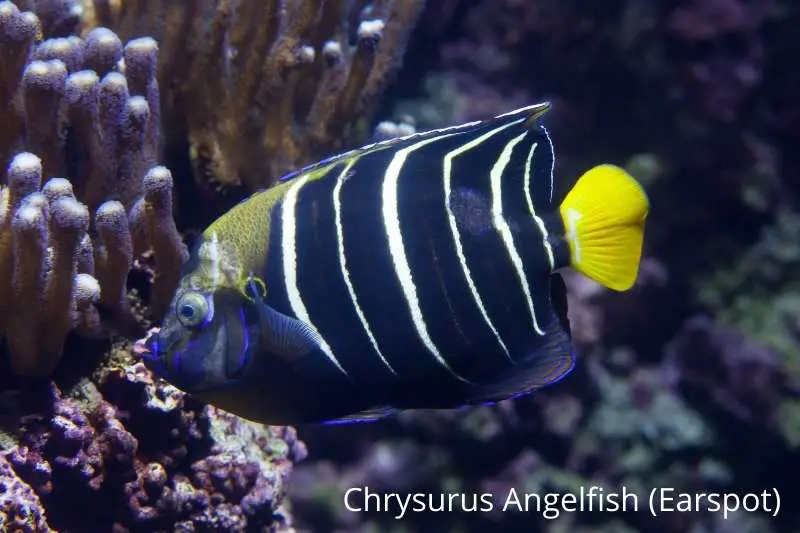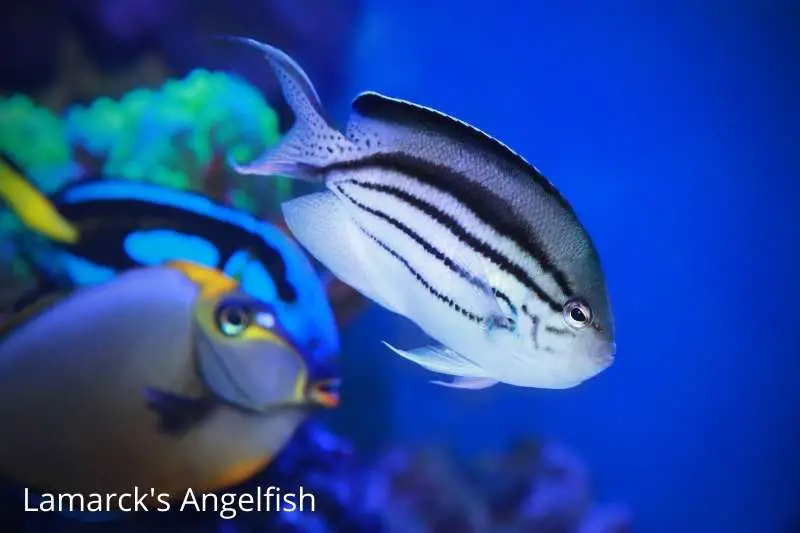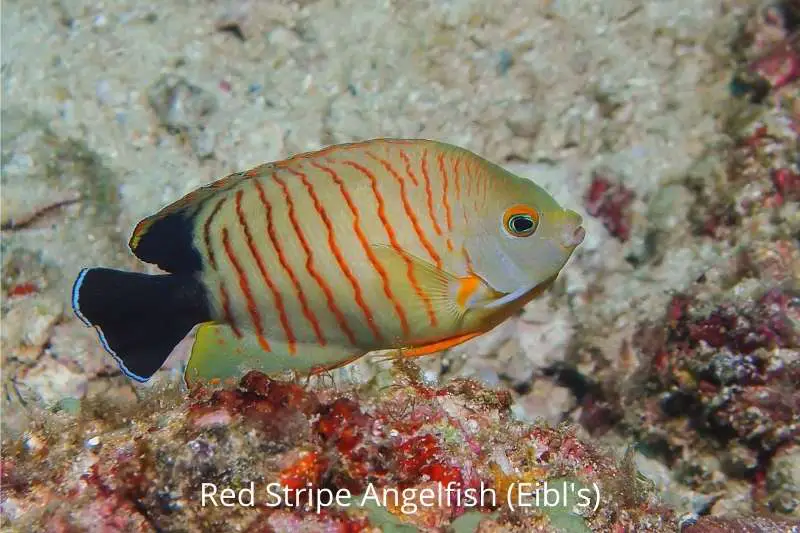Coral reefs are home to some amazing and brilliantly colored fish. Few types of saltwater fish species are as beautiful and diverse as the Saltwater Angelfish.
25 Most beautiful types of saltwater angelfish
1. Queen Angelfish: one of the most popular types of saltwater angelfish

The Queen Angelfish, Holacanthus ciliaris, is one of the largest types of saltwater angelfish species on this list and grows to a full adult size of 17.5-inches in length(Michael 2004). The minimum tank size to keep them in a saltwater aquarium is 220 gallons, which is a large tank for most homes (Source: Compatibility chart).
They come from Atlantic Ocean reefs from Brazil up to Bermuda, including the Gulf of Mexico.
Diet
The Queen Angelfish’s diet is comprised mainly of sponges, with tunicates, hydroids, and bryozoans mixed in. Juvenile Queen Angelfish may exhibit a cleaning behavior and will also eat filamentous algae.
Do Queen Angelfish swim in schools?
The Queen Angelfish is one of the types of saltwater angelfish that tends to swim in a harem group, including 1 male with 2 to 4 females.
Is the Queen Angelfish aggressive?
The Queen Angelfish is an aggressive saltwater fish that will defend its territory from fish added after it.
2. French Angelfish

The French Angelfish, Pomacanthus paru, grows to ~15-inches in length as a mature adult (Michael 2004). The minimum tank size to keep these types of saltwater angelfish in an aquarium is 220 gallons (Source: Compatibility chart).
Their natural range includes Atlantic Ocean reefs around the Bahamas, Florida, and The Gulf of Mexico south to Brazil.
Diet
The French Angelfish is omnivorous, eating sponges, macroalgae, corals, tunicates, hydroids, and bryozoans.
In a home aquarium, feed small meals of Angelfish-specific foods containing natural sponges, as well as both algae-enriched.
Juvenile fish may exhibit cleaning behaviors.
Do French Angelfish swim in schools?
The French Angelfish tends to swim in bonded pairs, not in schools.
Is the French Angelfish aggressive?
The French Angelfish is one of the most peaceful large angelfish species and tends to do well in a large community saltwater aquarium.
Related: Learn more about French Angelfish Care here.
3. Emperor Angelfish

The Emperor Angelfish, Pomacanthus imperator, is one of the world’s most beautiful marine angelfish species and grows to about 15-inches in length as a mature adult (Michael 2004). The minimum tank size to keep them in a saltwater aquarium is 220 gallons. (Source: Compatibility chart).
Their natural territory includes the reefs around Australia up to Japan in the Western Pacific Ocean and East to the Red Sea and Africa.
Diet
The Emperor Angelfish’s diet on a reef is made up mostly of sponges, tunicates, hydroids, and bryozoans, with some macroalgae mixed in.
If feeding in a reef tank, be sure to include Angelfish-specific foods for this type of saltwater angelfish that include a significant amount of sponge material as well as both meaty and algae-based formulations.

Juvenile fish may exhibit cleaning behaviors.
Do Emperor Angelfish swim in schools?
Multiple female Emperor Angelfish will live in a territory with a single large male that defends against other rival adult males.
Best to keep one fish per aquarium.
Is the Emperor Angelfish aggressive?
The Emperor Angelfish is a semi-aggressive saltwater fish.
Special considerations
Colors may fade in an aquarium over time, and the fish may be prone to HLLE, Head, and Lateral Line Erosion. Diet and water quality should be monitored closely.
4. Gray Angelfish

The Gray Angelfish, Pomacanthus arcuatus, grows to a tank-busting 19.5-inches in length as a mature adult (Michael 2004). The minimum tank size to keep these types of saltwater angelfish in a saltwater aquarium is 220 gallons (Source: Compatibility chart).
Their natural range includes Atlantic Ocean reefs around the Bahamas, Florida, and the Gulf of Mexico south to Brazil, the same as the French Angelfish.
Diet
The Gray Angelfish is omnivorous, eating sponges, macroalgae, corals, tunicates, hydroids, and bryozoans. Juveniles will eat parasites off the scales of neighboring fish, contributing to their diet.
In a home aquarium, feed small meals of Angelfish-specific foods containing natural sponges and algae-enriched algae.
Do Gray Angelfish swim in schools?
The Gray Angelfish tends to swim in bonded pairs or groups of up to 14 fish.
Is the Gray Angelfish aggressive?
The French Angelfish is considered semi-aggressive, particularly as a juvenile and towards fish introduced after it into the tank.
Is the Gray Angelfish reef safe?
The Gray Angelfish is NOT REEF SAFE. It may eat gorgonians, zoanthids, and other coral species.
5. Flame Angelfish

The Flame Angelfish, Centropyge loriculus, is a Dwarf Angel reef fish that grows to a petite ~4-inch total length (Michael 2004), making them a great addition to most aquariums 70-gallons or larger(Source: Compatibility chart).
Their natural range includes Pacific Island reefs, including Hawaii, and Australia.
Diet
The Flame Angelfish’s natural diet is mainly microalgae films, including diatoms, macroalgae, Caulerpa, and detritus.
Feed algae-enriched commercial foods, meaty foods, and nori sheets in the home aquarium
Do Flame Angels swim in schools?
The Flame Angelfish swims in a small group of one male fish with up to 7 mature females (Michael 2004). They are protogynous hermaphrodites being female at first before becoming male if necessary.
Is the Flame Angelfish aggressive?
The Flame Angelfish is considered semi-aggressive, indicating that it may have periodic territorial squabbles with other community fish.
Is the Flame Angelfish reef safe?
The Flame Angelfish IS REEF SAFE, although the occasional nipping at corals can not be ruled out.
Related: Read the Flame Angelfish Care Guide
6. Blueface Angelfish

- Scientific name: Pomacanthus xanthometopon
- Adult size: 15 inches – one of the larger species on this list
- Minimum tank size: 220 gallons
- Reef safe: No
7. Coral Beauty Angelfish

The Coral Beauty Angelfish, Centropyge bispinosus, is another Dwarf Angel that grows to an average size of ~4-inch total length (Michael 2004), making them another good choice for a saltwater tank that is at least 70 gallons (Source: Compatibility chart), and another one of the most popular types of saltwater angelfish.
Their natural range includes Tahiti, Australia (Great Barrier Reef), Japan, and East Africa.
Diet
The Coral Beauty Angelfish eats a varied diet, including macroalgae, microalgae, and detritus. Be sure to include algae-enriched foods in a home aquarium diet.
Do Coral Beauty Angels swim in schools?
The Coral Beauty Angelfish swims in a small group that includes a single dominant male fish with a small group of mature females (Michael 2004). Like other Dwarf Angels, they are protogynous hermaphrodites being female first before becoming male if necessary.
Is the Coral Beauty Angel aggressive?
The Coral Beauty Angelfish is semi-aggressive.
Is the Coral Beauty Angelfish reef safe?
The Coral Beauty Angelfish IS REEF SAFE, but any angelfish might nip at corals and clams.
Related: Read the Coral Beauty Angelfish Care Guide.
8. Pygmy Angelfish (Cherub)

The Pygmy Cherub Angelfish, Centropyge argi, is one of the most popular types of saltwater angelfish. As their name suggests, they are even small among other Dwarf Angel species, reaching only 3-inches in length as an adult. The minimum tank size to keep them in a saltwater aquarium is 70 gallons (Source: Compatibility chart).
They are found in the Tropical Atlantic Ocean reefs From Florida down through the Caribbean.
Diet
The Pygmy Angelfish eats filamentous algae, cyanobacteria, and detritus on the live rock. Be sure to include algae-enriched foods in a home aquarium diet.
Do Cherub Angelfish swim in schools?
The Cherub Angelfish swims in small groups, including a male and 1 to 3 females(Michael 2004).
Is the Cherub Angel aggressive?
The Cherub Angelfish is semi-aggressive. Despite its small size, it can terrorize docile fish.
Is the Pygmy Angelfish reef safe?
The Cherub Angelfish IS REEF SAFE.
9. Regal Angelfish

The Regal Angelfish is one of the most colorful and popular saltwater angelfish types for good reason. Just take a look at the image above. Here are some quick facts about them:
- Scientific name: Pygoplites diacanthus
- Common names: Regal angelfish, Royal angelfish
- Adult size: 10-inches
- Minimum tank size: 125 gallons
- Reef safe: With caution; can be kept with SPS and chemically-potent soft corals
- Aggressiveness: Semi-aggressive
- Natural habitat: Indian ocean, Pacific Ocean, Red Sea, Southern Japan, and Australia
10. King Angelfish

Here are a few important quick facts about the King Angelfish, one of the most popular saltwater angelfish types:
- Scientific name: Pygoplites diacanthus
- Maximum size: 14 inches; one of the bigger species
- Minimum tank size: 220 gallons
- Reef safe: No
- Aggressiveness: Semi-aggressive
11. Potter’s Angelfish

One look at the Potter Angelfish, and you can tell why it is one of the most popular types of saltwater angelfish. Here are a few important quick facts:
- Scientific name: Centropyge potteri
- Adult size: 5 inches
- Minimum tank size: 70 gallons
- Reef safe: With caution
- Aggressiveness: Semi-aggressive
12. Chrysurus Angelfish

- Scientific name: Pomacanthus chrysurus
- Adult size: 13 inches
- Minimum tank size: 220 gallons
- Reef safe: With caution; can be kept with SPS and chemically-potent soft corals
- Aggressiveness: Semi-aggressive
13. Lemonpeel Angelfish

- Scientific name: Centropyge flavissima
- Adult size: 5.5 inches
- Minimum tank size: 70 gallons
- Reef safe: With caution
- Aggressiveness: Semi-aggressive
14. Bicolor Angelfish

I am not sure whether the Bicolor Angelfish is blue with yellow or yellow with blue, but I am sure that it is one of the most popular types of saltwater angelfish.
Scientific name: Centropyge bicolor
Adult size: 6 inches
Minimum tank size: 70 gallons
Reef safe: With caution
Aggressiveness: Semi-aggressive
Related: Read the Bicolor Angelfish Care Guide, a great option, whether you’re looking for a yellow or blue angelfish.
15. Koran Angelfish

The Koran Angelfish is not reef safe, but it is one of the most popular types of saltwater angelfish because its hardiness.
- Scientific name: Pomacanthus semicirculatus
- Adult size: 15 inches
- Minimum tank size: 220 gallons
- Reef safe: No
- Aggressiveness: Semi-aggressive
16. Lamarck’s Angelfish

- Scientific name: Genicanthus lamarck
- Adult size: 8 inches
- Minimum tank size: 125 gallons
- Reef safe: Yes
- Aggressiveness: Peaceful
17. Scribbled

- Scientific name: Chaetodontoplus duboulayi
- Adult size: 10 inches
- Minimum tank size: 180 gallons
- Reef safe: With caution
- Aggressiveness: Semi-aggressive
18. Annularis Angelfish

- Scientific name: Pomacanthus annularis
- Adult size: 12 inches
- Minimum tank size: 220 gallons
- Reef safe: With caution
- Aggressiveness: Semi-aggressive
19. Red Stripe Angelfish

- Scientific name: Centropyge eibli
- Adult size: 6 inches
- Minimum tank size: 70 gallons
- Reef safe: With caution
- Aggressiveness: Semi-aggressive
20. Keyhole Angelfish

- Scientific name: Centropyge tibicin
- Adult size: 8 inches
- Minimum tank size: 70 gallons
- Reef safe: With caution
- Aggressiveness: Semi-aggressive
21. Peppermint Angelfish

The Peppermint Angelfish is infamous on this list because it is one of the rarest types of angelfish you will find in a saltwater aquarium. This deep water species does not commonly show up in the trade and therefore commands premium pricing.
- Scientific name: Paracentropyge boylei
- Adult size: 3 inches
- Minimum tank size: 55 gallons
- Care level: Extremely difficult, rare fish
22. Goldflake Angelfish

- Scientific name: Apolemichthys xanthopunctatus
- Adult size: 10 inches
- Minimum tank size: 125 gallon tank
- Reef safe: With caution
- Aggressiveness: Semi-aggressive
23. Rock Beauty Angelfish

- Scientific name: Holacanthus tricolor
- Adult size: 8 inches
- Minimum tank size: 125 gallon tank
- Reef safe: With caution
- Aggressiveness: Semi-aggressive
- Difficulty: Extremely difficult due to the need for sponges in the diet
24. Majestic Angelfish

- Scientific name: Pomacanthus navarchus
- Adult size: 12 inches
- Minimum tank size: 70 gallons
- Reef safe: With caution
- Aggressiveness: Semi-aggressive
Related: Read the Majestic Angelfish Care Guide
25. Bandit Angelfish

The Bandit Angelfish is one of the most popular types of angelfish because of the fantastic coloration it displays, but it is challenging to care for successfully because of the significant amount of sponges in its diet. Here are a few quick facts:
- Scientific name: Centropyge flavissima
- Adult size: 7 inches
- Minimum tank size: 70 gallons
- Reef safe: With caution
- Aggressiveness: Semi-aggressive
A list of the 25 Popular Types of Saltwater Angelfish
Here is a list of 25 Popular Types of Saltwater Angelfish Species
- Queen Angelfish
- French Angelfish
- Emperor Angelfish
- Gray Angelfish
- Flame Angelfish
- Blueface Angelfish
- Coral Beauty Angelfish
- Pygmy Angelfish
- Regal Angelfish
- King Angelfish
- Potter’s Angelfish
- Chrysurus Angelfish
- Lemonpeel Angelfish
- Bicolor Angelfish
- Koran Angelfish
- Lamarck’s Angelfish
- Scribbled Angelfish
- Annularis Angelfish
- Red Stripe Angelfish
- Keyhole Angelfish
- Peppermint Angelfish
- Goldflake Angelfish
- Rock Beauty Angelfish
- Blue-Girdled Angelfish
- Bandit Angelfish
Dwarf angelfish species tank mates
If you plan to keep any of the small angelfish in this list of 25 types of saltwater angelfish species, here is a list of potential tank mates to start your research:
- Clownfish
- Chromis
- Basslets & grammas
- Tangs
- Gobies
- Blennies
- Cardinalfish

Large angelfish species tank mates
If you plan to keep any of the large angelfish in this list of 25 types of saltwater angelfish species, here is a list of potential tankmates to start your research, including a few larger fish suitable for a tank that size:
- Tangs
- Butterflyfish
- Boxfish
- Clownfish
- Wrasses
- Goatfish
- Rabbitfish
- Sweetlips
Ideal tank conditions
Water quality matters if you’re going to try to keep any of these Types of Saltwater Angelfish in an aquarium. The ideal water parameters are:
- Temperature: 73-84 Fahrenheit
- pH: 8.1 to 8.4
- Salinity: 1.025 specific gravity or 35 ppt
- Ammonia, Nitrites: 0 ppm
- Nitrates: can be more than 0ppm but keep low ~10-30 ppm
One important aspect of creating the ideal tank conditions for any of these 25 types of saltwater angelfish is to achieve a stable water parameter within the range and keep it consistent. Water parameters within the target range but fluctuate a lot can cause problems in the same way as exceeding the recommended ranges.
Feeding large angelfish species
Angelfish eat a lot, and constantly, all day long. In one study involving some popular types of saltwater angelfish, the fish studied took 3 bites per minute (Michaels 2004). Since they also have complex diets, often requiring sponges, it is best to feed them an angelfish-specific food that includes sponges about 5 times a day, if possible.
You should plan to have a variety of live foods, like brine shrimp and copepods, as well as a few different frozen foods on hand to entice picky eaters when they first arrive at your home.
What is the hardiest type of saltwater angelfish species?
The hardiest saltwater angelfish species is the Coral Beauty, which adapts well to aquarium life, doesn’t require a special diet, and is suitable for tanks 70 gallons in volume and larger.
Can saltwater angelfish be kept together?
Small groups of marine angelfish tend to occupy the same territory on tropical reefs, but this can be challenging to recreate in a home aquarium due to aggression between individual fish. The Dwarf Angelfish are hermaphroditic, so it is possible to establish a pair, but this is best left to those with significant experience.
Which angelfish is reef safe?
The most popular species of reef-safe angelfish are:
- Coral beauty
- Flame
- Cherub
… Click here to learn about 10 other great reef-safe angelfish species.
References
Michael, Scott W. Angelfishes & Butterflyfishes: Plus Ten More Aquarium Fish Families With Expert Captive Care Advice for the Marine Aquarist. T.F.H. Publications. Neptune City, NJ 2004.
Ulrich III, Albert B. The New Saltwater Aquarium Guide: How to Care for and Keep Marine Fish and Corals. Saltwater Aquarium Blog Publishing. 2014.


Leave a Reply